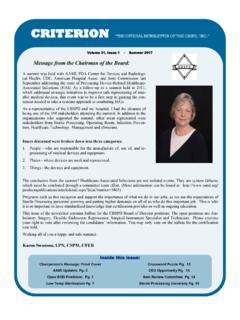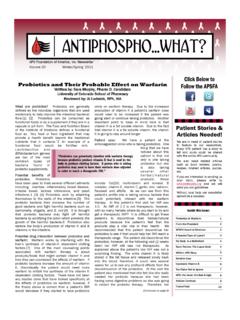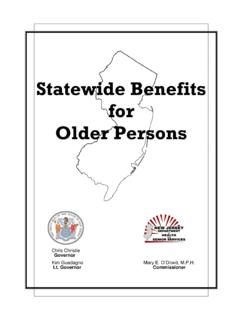Transcription of Volume 21, Issue 1 Winter 2018 - sterileprocessing.org
1 CRITERION THE OFFICIAL newsletter OF THE CBSPD, INC.. Volume 21, Issue 1 - Winter 2018. Message from the Chairman of the Board: Happy New Year! I hope 2018 will be a good year for everyone. Effective December 31, 2017, I regretfully resigned as Chairman of the Board. My elderly parents have been in poor health for the past year and caring for them has become a huge demand on my time. This was a difficult decision to make, because the CBSPD has been a very important part of my life for many years. But, with so many personal demands, I can no longer devote the time necessary to ef- fectively lead the CBSPD. It has been both a pleasure and an honor to have served the CBSPD, and all of you certificants over the past 4 years as Chairman of the Board. I have had the opportunity to meet so many people who are truly devoted to the Sterile Processing profession. I also had the pleasure of representing the CBSPD throughout the United States and in Mexico, South America and Dominican Republic to speak about the importance of certification.
2 I wish the CBSPD and all of you the very best in the future. With kindest regards, Karen Swanson Karen LPN, CSPM. Farewell and Good Luck Karen Swanson The CBSPD would like to take this time to thank Karen Swanson for her many years of service, not only to the Board of Directors but also for her personal time sacrificed to make the importance of Sterile Processing know world wide. Her drive, actions and performance has increased the knowledge of the importance of the certification and has advanced the visibility of Sterile Processing to a nationwide level. She will truly be missed, but we look forward to continue to consult with her for years to come. Due to Karen's resignation, we will soon be announcing the reorganization of the CBSPD Board of Directors for 2018. INSIDE THIS Issue . Chairperson's Message: Front Cover Word Search Pg. 7. AAMI Updates: Pg. 2 CEU Post Test Pg. 8.
3 New BOD Members: Pg. 3 CEU Review Committee Article Pg. 9. GI Endoscopes: Biofilm Pg. 5 Recertification Reminder Pg. 12. Page 2 CRITERION THE OFFICIAL newsletter OF THE CBSPD, INC.. Report on the Association for the Advancement of Medical Instrumentation (AAMI) - Nancy Chobin, RN, CSPM, CFER. AAMI ST79 UPDATE From October 2017, Baltimore Meeting: As many of you are aware, the ST79 AAMI Steam Sterilization standards have been updated. This is the first update since 2013. Below are highlights of some of the changes. Temperature and Humidity Documentation In the 2013 Document, there were specific temperature and humidity requirements for the various areas in the SPD. AAMI now states parameters should be established according to the ANSI/ASHRE/ASHE 170 version when the HVAC system was initially installed or last updated. Monitoring results should be able to be retrieved from either a central or local log.
4 Mechanical Cleaning Equipment Testing Section states, Mechanical cleaning equipment performance should be tested each day it is used and all results should be recorded. This is more specif- ic than was in the 2013 Document. In March, AAMI will AAMI/ANSI ST-81 Information to be Provided by Device Manufactures meet in in More emphasis is being placed on reference to device manufacturers' instructions Baltimore, for cleaning and sterilization. Rather than stating standard sterilization cycles, MD. reference is now made to ANSI/AAMI ST81, ANSI/AAMI ST55 and FDA. (2015) for standard sterilization cycles. Immediate Use Sterilization Items to be sterilized using immediate use steam sterilization (IUSS) should be placed into rigid sterilization containers that have been validated for immediate use cycles. Chemical Indicator Placement Placement of internal chemical indicators has been modified.
5 A significant change is that one chem- ical indicator should be placed, so it is visible to the person opening the package. Page 3 CRITERION THE OFFICIAL newsletter OF THE CBSPD, INC.. Meet the New Members of the Board of Directors GI Scope Representative Chris Franklin joined the CBSPD board of directors as the GI Scope Representative in November 2017. He has been working in the field for several years, and currently works in downtown Indianapolis at IU Health Methodist Hospital as an Endoscopy Tech. Chris is very involved in the industry, having worked with several organizations and even runs a website devoted to uniting Sterile Processing Professionals. He is also the Endoscopy Unit Representative for the SGNA. Infection Prevention and AAAHC Infection Prevention Champion programs. Chris started working in the sterile processing field by chance and hasn't turned back since.
6 He has said, Sterile processing is a rewarding career with lots of opportunity, I. believe I have truly found my calling in this work.' Ever since beginning his career, Chris has always looked for op- Chris Franklin portunities to grow and ways to make things more efficient. He is currently attending school for Business Administra- tion, and hopes to take on a administrative role in sterile pro- cessing in the future.. Surgical Instrument Specialist Representative Natoria Pettyjohn has been working in the medical field for over ten years. She attended Harris School of Business and received her diploma in Surgical Tech- nology in 2010. Then, received her associates degree in Healthcare Management from Virginia College in 2013. Traveling nationwide as a travel sterile pro- cessing technician for the past five years, Natoria is continuing to travel and educate others in the im- portance of sterilization.
7 She is currently employed as an surgical consultant for Steris. When not working she enjoys playing, Words with Friends, with her husband of six years and singing songs with her two Natoria Pettyjohn girls. Volume 21, Issue 1 - Winter 2018 Page 4. Meet the New Members of the Board of Directors CSPDT Representative Deborah Hager, CSPDT is from Arkport, New York, a small town in the southern tier of New York state. Being married to a United States Marine for nearly twenty years allowed Deborah to reside in several parts of North Carolina and even overseas in Okinawa, Japan. Raising three children along the way was her main focus. When the children were older, it became a priority to move closer to family, back in upstate New York. When a near by hospital was hiring, it seemed like a good opportuni- ty. Starting at Noyes Hospital in Dansville, New York as a telecommunication attendant, Deborah worked only part time.
8 She enjoyed the hospital setting. She noticed there was a full time job posted for a Sterile Processing Technician. Not being familiar with this field, she per- formed some research. To her surprise, she found Sterile Processing was intriguing and she interviewed for the job. Deborah Hager The Supervisor explained what a Sterile Processor was and without hesitation she accepted the job. In 2008, she began learning and doing all the tasks of a Sterile Processor and never looked back. This situation encouraged her to pursue certification in 2011. The more experi- ence and knowledge she gained, boasted her confidence so she applied to a bigger hospital out of town. Now divorced, she needed a change. That is exactly how Deborah started working at Highland Hospital in Rochester, New York. After two years of commuting over fifty miles to work, she left there as a shift supervisor and returned to Noyes Hospital.
9 This enabled her to be closer to her children and grandchildren. Deborah is also creating a new home, with a new life partner. Together, they spend time with their children, family, dog and friends. Thank You!! The CBSPD would like to thank all certified members who voted for their respec- tive representatives. We would also like to thank each one of our new board mem- bers for the time they will and have already sacrificed, to ensure that the CBSPD. is continually meeting the needs of our members and the professionalism that will continue to advance the care of patients world wide. Volume 21, Issue 1 - Winter 2018 Page 5. GI Endoscopes: Biofilm By: Christopher Franklin, CFER. What is Biofilm? What is biofilm? This is a term that is commonly used in sterile processing and more specifically in flexible endoscope reprocessing. Biofilms are groups of tightly packed cells that attach to surfaces, and secrete a slimy glue-like substance that protects them, allowing microorganisms to adhere to a surface.
10 You can find biofilm everywhere, including river rocks and even your teeth. These biofilms form when non-sterile water comes in contact with a non-shedding surface. If the biofilm is given the opportunity to mature, it can inhibit the effectiveness of enzymatics and detergents, making cleaning and disinfecting very difficult. In fact, bacteria within biofilms can be as much as 1,000 more resistant to antimicrobial so- lutions than bacteria alone. The development of biofilm happens in 5 stages; initial attachment, irreversible attachment, matu- ration I, maturation II and dispersion. Microorgan- isms must first come in contact with and attach to a surface. If given the opportunity, these microorgan- isms will then begin to grow and mature. Once the biofilm has fully matured, it can then begin to dis- perse and colonize elsewhere. Effects on endoscopes. The impact of biofilm on flexible endo- scopes can be very problematic, and could even re- sult in deadly outcomes if bacteria is transmitted from patient to patient.











